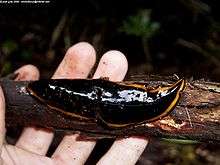Polycladus
Polycladus is a genus of land planarians from South America, currently comprising a single species, Polycladus gayi, which occurs in the Valdivian Forest, Chile.
| Polycladus | |
|---|---|
 | |
| Polycladus gayi | |
| Scientific classification | |
| Kingdom: | |
| Phylum: | |
| Class: | |
| Order: | |
| Suborder: | |
| Family: | |
| Subfamily: | |
| Genus: | Polycladus Blanchard, 1847 |
| Species: | P. gayi |
| Binomial name | |
| Polycladus gayi Blanchard, 1847 | |
| Synonyms | |
|
Geoplana gayi Schultze & Müller, 1857 | |
Description
Polycladus is a very understudied genus of land planarians. It was defined as land planarians with a wide, flat and leaf-like body, having the entire ventral surface ciliated and with mouth and gonopore posteriorly shifted in relation to other land planarians. The copulatory apparatus has a well-developed permanent penis and the female canal enters the genital antrum ventrally.[1] This definition, however, is incomplete regarding all anatomical structures currently considered in the definition of planarian genera.[2]
Etymology
The name Polycladus comes from Greek πολύ (many) + κλάδος (branch), referring to the branched intestine. Despite the name, Polycladus is not a species of the flatworm order Polycladida, but rather of Tricladida.
The specific epithet of the type-species, gayi, commemorates French naturalist Claude Gay.[3]
References
- Ogren, R. E. and Kawakatsu, M. (1990). Index to the species of the family Geoplanidae (Turbellaria, Tricladida, Terricola) Part I: Geoplaninae. Bulletin of Fujis Women's College. 29: 79-166.
- Carbayo, F.; Álvarez-Presas, M.; Olivares, C. U. T.; Marques, F. P. L.; Froehlich, E. X. M.; Riutort, M. (2013). "Molecular phylogeny of Geoplaninae (Platyhelminthes) challenges current classification: Proposal of taxonomic actions". Zoologica Scripta. 42 (5): 508. doi:10.1111/zsc.12019.
- Blanchard, Émile (1847). "Recherches sur l'organisation des vers". Annales des Sciences Naturelles, Zoologie, 3e série. 8: 119–149. doi:10.5962/bhl.title.51506.
